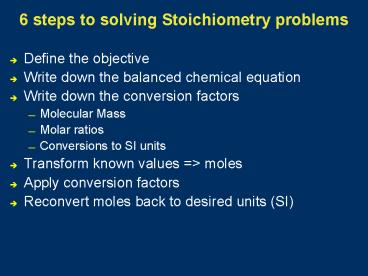6 steps to solving Stoichiometry problems - PowerPoint PPT Presentation
1 / 17
Title:
6 steps to solving Stoichiometry problems
Description:
6 steps to solving Stoichiometry problems – PowerPoint PPT presentation
Number of Views:149
Avg rating:3.0/5.0
Title: 6 steps to solving Stoichiometry problems
1
6 steps to solving Stoichiometry problems
- Define the objective
- Write down the balanced chemical equation
- Write down the conversion factors
- Molecular Mass
- Molar ratios
- Conversions to SI units
- Transform known values gt moles
- Apply conversion factors
- Reconvert moles back to desired units (SI)
2
It all comes down to MOLES
3
Mass-Mole relationship in Chemical Reaction
4
How much hydrogen is required to produce one ton
of ammonia?
5
Hydrogen Example
- Hydrogen can come from natural gas or petroleum
- Cost of processes using H2 are usually determined
by the cost of the H2 - For the Production of Ammonia
- How much hydrogen is required to produce one ton
of ammonia?
6
6 steps to solving Stoichiometry problems
- 1. Define the objective
- 2. Write down the balance chemical equation
- 3. Write down the conversion factors
- 4. Transform known values gt moles
- 5. Apply conversion factors
- 6. Reconvert moles back to desired SI units
7
Ammonia Example
- 1. Define the objective
- Amount of H2 in grams needed for 1 ton of NH3
- 2. Write down the balance chemical equation
- 3. Write down the conversion factors
8
Common Conversion Scheme
- Mass of A gt moles of A
conversion factors
moles of B gt grams of B
9
Ammonia example Step 3
- 3. Write down the conversion factors
- Start with molecular weights
- 1 mole N2 28.02 grams (2 x 14.01)
- 1 mole of H2 2.016 grams (2 x 1.008)
- 1 mole of NH3 17.03 grams (14.01 3 x 1.008)
- Conversions needed for SI units
- 1 ton 907 kg
- Stoichiometric (mole) ratios based on Balanced
Eq. - 3 moles H2 per 1 mole of N2
- 3 moles H2 per 2 moles of NH3
- 1 mole N2 per 2 moles of NH3
10
Ammonia example Step 4
- 4. Transform known values gt moles
- Look for limiting reagents
- Use limiting reagent to determine the amount of
product formed - Key is if two known values are given
- assume excess of others if only one is given
11
Factor Label Method
- 4. Transform known values gt moles
- Mass A gt Mole A
1 ton NH3
907 kg
Mole NH3
1000 g
mol NH3
5.326x104
1 kg
1 ton
17.03 g NH3
12
Ammonia example Step 5
- 5. Apply conversion factors
- keep in mind defined objective
- amount in grams of H2
- Moles A gt Moles B
5.326x104 mol NH3
3 mol H2
mol H2
7.989x104
2 mol NH3
13
Ammonia example Step 6
- 6. Reconvert moles back to desired SI units
7.989x104 mol H2
2.016 g H2
1.611x105 g H2
mol H2
1.611x105 g H2 161 kg H2
14
Stoichiometry - Table method
Problem
907 kg
?
Equation
Formula Masses, g
28.02
2.016
17.03
3
2
Recipe, mol
15
Stoichiometry - Table method
Problem
907 kg
?
Equation
Formula Masses, g
28.02
2.016
17.03
3
2
Recipe, mol
907 kg NH3
1 mol NH3
3 mol H2
2.016 g H2
17.03 g NH3
2 mol NH3
mol H2
161 kg H2
16
Stoichiometry - Table method
Problem
907 kg
?
Equation
Formula Masses, g
28.02
2.016
17.03
3
2
Recipe, mol
907 kg NH3
1 mol NH3
3 mol H2
2.016 g H2
17.03 g NH3
2 mol NH3
mol H2
161 kg H2
17
Practice in small groups4.2.1, 4.2.2































